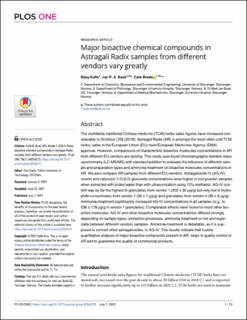| dc.contributor.author | Kafle, Bijay | |
| dc.contributor.author | Baak, Jan P.A. | |
| dc.contributor.author | Brede, Cato | |
| dc.date.accessioned | 2021-09-16T13:40:33Z | |
| dc.date.available | 2021-09-16T13:40:33Z | |
| dc.date.created | 2021-07-08T08:19:23Z | |
| dc.date.issued | 2021-07 | |
| dc.identifier.citation | Kafle, B., Baak, J.P.A., Brede, C. (2021) Major bioactive chemical compounds in Astragali Radix samples from different vendors vary greatly. PLOS ONE, 16(7): e0254273 | en_US |
| dc.identifier.issn | 1932-6203 | |
| dc.identifier.uri | https://hdl.handle.net/11250/2778673 | |
| dc.description.abstract | The worldwide traditional Chinese medicine (TCM) herbs sales figures have increased considerably to 50 billion US$ (2018). Astragali Radix (AR) is amongst the most often sold TCM herbs; sales in the European Union (EU) need European Medicines Agency (EMA) approval. However, comparisons of characteristic bioactive molecules concentrations in AR from different EU vendors are lacking. This study uses liquid chromatography-tandem mass spectrometry (LC-MS/MS) with standard addition to evaluate the influence of different sample and preparation types and ammonia treatment on bioactive molecules concentrations in AR. We also compare AR samples from different EU-vendors. Astragaloside IV (AG-IV), ononin and calycosin 7-O-β-D-glucoside concentrations were higher in root powder samples when extracted with boiled water than with ultrasonication using 70% methanol. AG-IV content was by far the highest in granulates from vendor 1 (202 ± 35 μg/g) but very low in hydrophilic concentrates from vendor 1 (32 ± 7 μg/g) and granulates from vendor 4 (36 ± 3 μg/g). Ammonia-treatment significantly increased AG-IV concentrations in all samples (e.g., to 536 ± 178 μg/g in vendor 1 granulates). Comparable effects were found for most other bioactive molecules. AG-IV and other bioactive molecules concentrations differed strongly depending on sample types, extraction processes, ammonia treatment-or-not and especially between different vendors samples. Ammonia-treatment is debatable, as it is supposed to convert other astragalosides, to AG-IV. The results indicate that routine quantitative analysis of major bioactive compounds present in AR, helps in quality control of AR and to guarantee the quality of commercial products. | en_US |
| dc.language.iso | eng | en_US |
| dc.publisher | Public Library of Science (PLoS) | en_US |
| dc.rights | Navngivelse 4.0 Internasjonal | * |
| dc.rights.uri | http://creativecommons.org/licenses/by/4.0/deed.no | * |
| dc.subject | kinesisk naturmedisin | en_US |
| dc.subject | Astragali radix (AR) | en_US |
| dc.title | Major bioactive chemical compounds in Astragali Radix samples from different vendors vary greatly | en_US |
| dc.type | Peer reviewed | en_US |
| dc.type | Journal article | en_US |
| dc.description.version | publishedVersion | en_US |
| dc.rights.holder | © 2021 Kafle et al. | en_US |
| dc.subject.nsi | VDP::Matematikk og Naturvitenskap: 400::Kjemi: 440 | en_US |
| dc.source.pagenumber | 1-13 | en_US |
| dc.source.volume | 16 | en_US |
| dc.source.journal | PLOS ONE | en_US |
| dc.source.issue | 7 | en_US |
| dc.identifier.doi | 10.1371/journal.pone.0254273 | |
| dc.identifier.cristin | 1920892 | |
| dc.source.articlenumber | e0254273 | en_US |
| cristin.ispublished | true | |
| cristin.fulltext | original | |
| cristin.qualitycode | 1 | |

